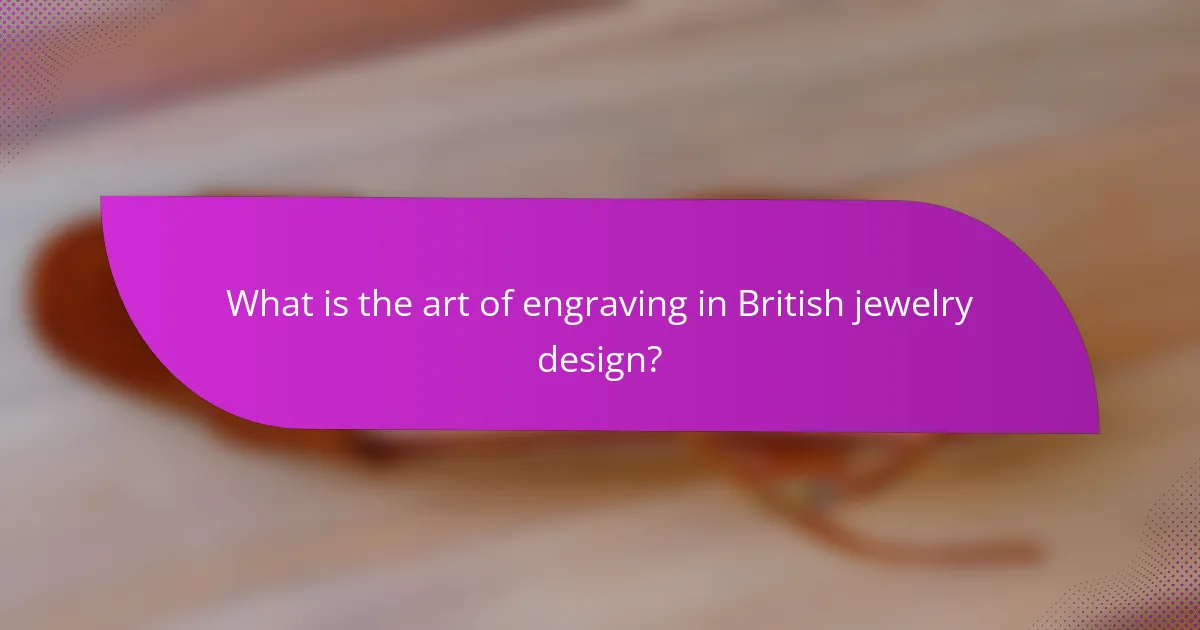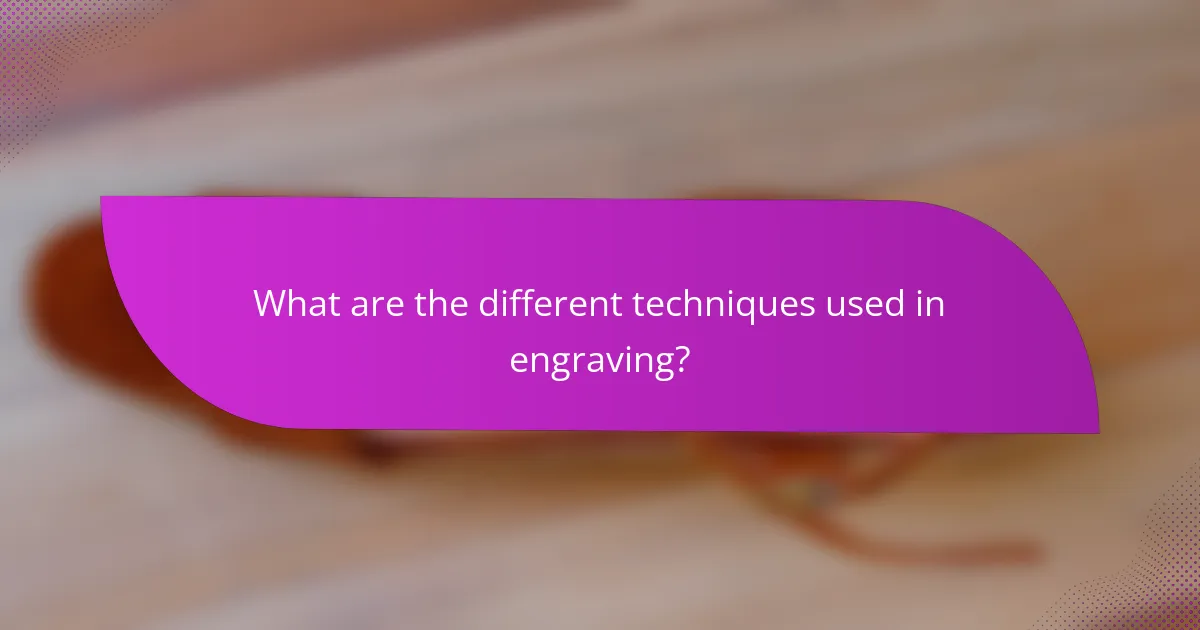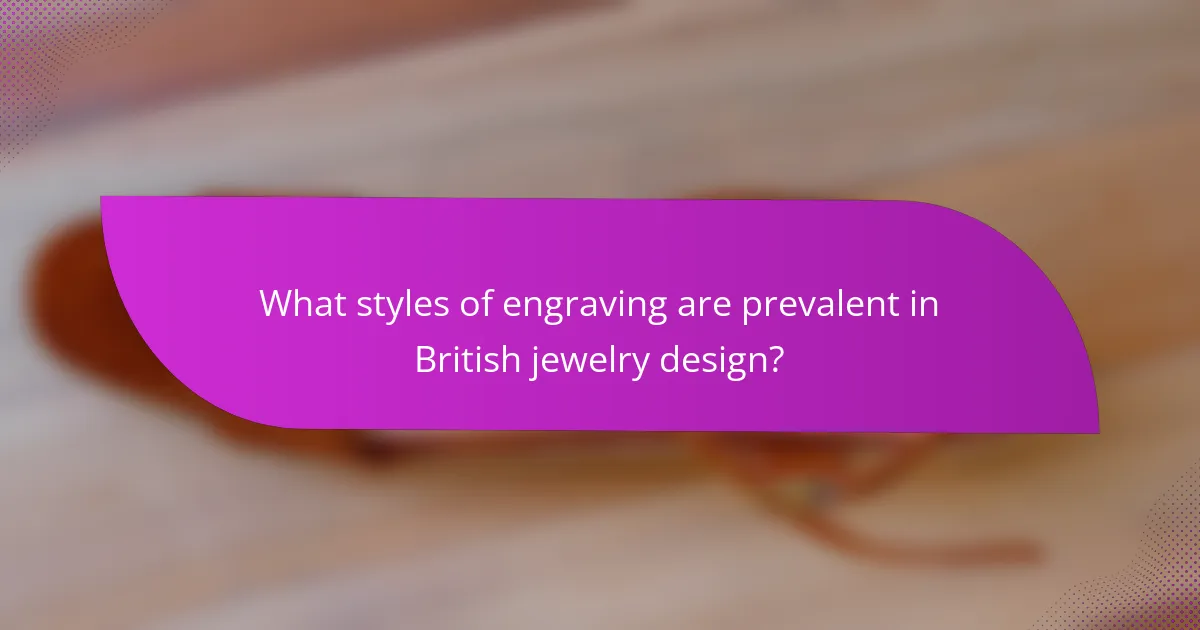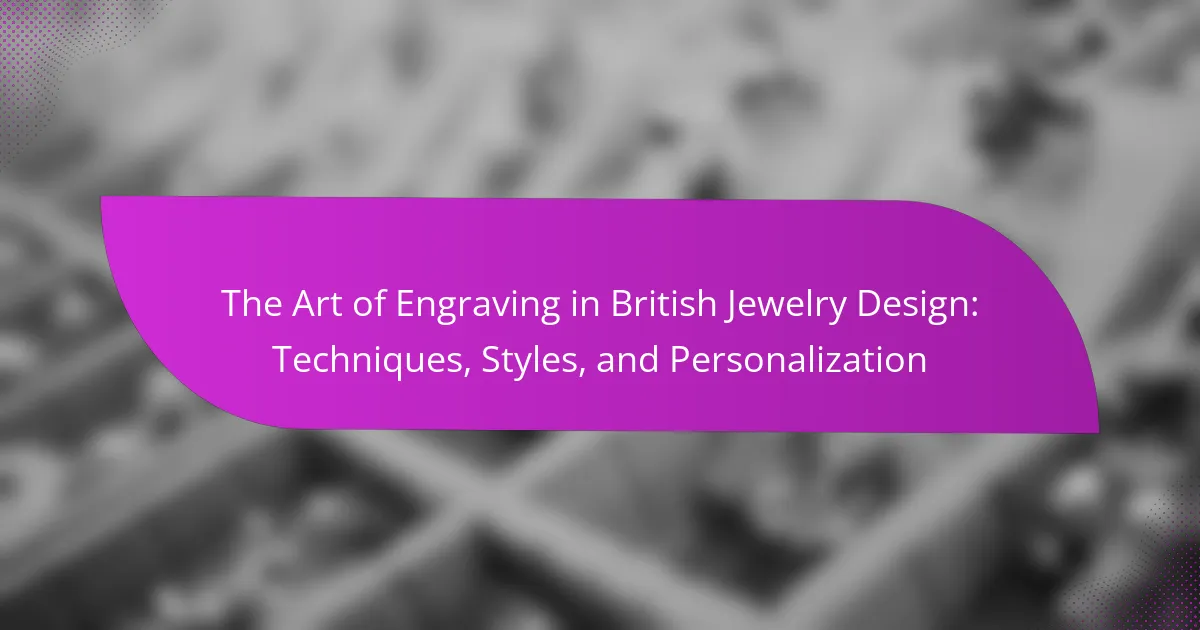The art of engraving in British jewelry design encompasses the intricate practice of carving designs into metal surfaces, enhancing both aesthetic appeal and personal significance. This technique, with historical roots dating back to the 16th century, allows artisans to add detailed patterns, initials, or motifs to various jewelry items such as rings, bracelets, and pendants. Key engraving techniques include intaglio, relief, and laser engraving, each offering unique artistic expression and detail. Popular styles in British jewelry include hand engraving, which allows for intricate personalization, machine engraving for precision in mass production, and laser engraving for versatility and speed. Collectively, these methods contribute to the distinctive craftsmanship and innovation seen in British jewelry.

What is the art of engraving in British jewelry design?
The art of engraving in British jewelry design involves the intricate practice of carving designs into metal surfaces. This technique enhances the aesthetic appeal and personal significance of jewelry pieces. Engraving has historical roots in British craftsmanship, dating back to the 16th century. It allows for detailed patterns, initials, or motifs to be added to rings, bracelets, and pendants. Various tools and methods, such as hand engraving and machine engraving, are employed by artisans. The precision of engraving contributes to the uniqueness of each piece. Moreover, it plays a significant role in personalization, making jewelry items meaningful to the wearer.
How has engraving evolved in British jewelry design over the years?
Engraving in British jewelry design has evolved significantly over the years. Initially, engraving was a labor-intensive process used primarily for personalization and decorative purposes. In the 18th century, techniques such as stippling and line engraving became popular, enhancing detail in designs. The Victorian era saw a rise in sentimental pieces, often engraved with initials or meaningful symbols. The introduction of new tools in the 19th century improved precision and allowed for more intricate designs. In the 20th century, engraving began to incorporate modern techniques, including laser engraving, which offered greater accuracy and versatility. Today, engraving combines traditional craftsmanship with advanced technology, allowing for unique customization in contemporary jewelry.
What historical influences shaped the techniques of engraving?
The techniques of engraving have been shaped by various historical influences. The invention of the printing press in the 15th century increased demand for engraved illustrations. This technological advancement allowed engravers to reproduce images and texts more efficiently. The Renaissance period also played a crucial role, as artists began to explore new styles and techniques. Influential figures like Albrecht Dürer advanced engraving methods, emphasizing detail and perspective. Additionally, the rise of the middle class in the 17th century created a market for personalized engraved jewelry. This demand led to innovations in tools and techniques, enhancing the art form. The combination of these historical factors significantly influenced the evolution of engraving techniques.
What role did cultural movements play in the development of engraving styles?
Cultural movements significantly influenced the development of engraving styles. Each movement brought distinct themes and aesthetics to the art of engraving. For instance, the Renaissance emphasized realism and perspective, leading to more intricate and lifelike engravings. The Baroque period introduced dramatic contrasts and emotional expression, which shaped the style of engravings to reflect grandeur.
The Arts and Crafts movement prioritized craftsmanship and natural forms, inspiring engravers to focus on organic motifs and simplicity. Additionally, the Art Nouveau movement embraced flowing lines and ornamental designs, which transformed engraving techniques to create more fluid and decorative pieces.
These cultural shifts not only impacted the visual aspects of engraving but also the materials and tools used. The evolution of engraving styles can be traced through these movements, showcasing how societal values and artistic philosophies shaped the medium.
Why is engraving significant in the context of jewelry design?
Engraving is significant in jewelry design because it enhances personalization and aesthetic appeal. This technique allows for intricate designs and messages to be added to pieces. Engraving can transform a standard item into a unique expression of individuality. Historically, engraved jewelry has been used for sentimental purposes, often featuring initials or dates. This practice dates back centuries, highlighting its enduring relevance. Custom engravings can increase the emotional value of jewelry, making it a cherished heirloom. The precision of engraving also showcases the craftsmanship involved in jewelry design. Overall, engraving elevates jewelry from mere adornment to a meaningful art form.
What emotional and personal value does engraving add to jewelry pieces?
Engraving adds significant emotional and personal value to jewelry pieces. It allows individuals to personalize items with meaningful messages or symbols. This personalization transforms a standard piece into a unique treasure. Engraved jewelry often commemorates special occasions, such as weddings or anniversaries. It can also serve as a reminder of loved ones or significant life events. The act of engraving creates a deeper connection between the wearer and the jewelry. Many people cherish engraved pieces for their sentimental significance. This emotional attachment enhances the overall value of the jewelry beyond its material worth.
How does engraving enhance the aesthetic appeal of jewelry?
Engraving enhances the aesthetic appeal of jewelry by adding intricate designs and personal touches. This technique allows for customization, making pieces unique to the wearer. Engraved patterns can reflect personal stories or significant events. Additionally, engraving can create visual depth, drawing attention to the jewelry. The craftsmanship involved in engraving often elevates the overall quality and value of the piece. Historical records show that engraved jewelry has been prized for centuries, demonstrating its lasting appeal. Engraving also allows for the incorporation of symbols or initials, further personalizing the jewelry. Overall, this technique significantly enriches the visual and emotional value of jewelry.

What are the different techniques used in engraving?
The different techniques used in engraving include intaglio, relief, and laser engraving. Intaglio involves carving designs into a surface, creating a recessed image. Relief engraving raises the design above the surface level. Laser engraving uses high precision lasers to etch designs onto various materials. Each technique allows for unique artistic expression and detail. Intaglio is often used in printing and jewelry design. Relief engraving is common in decorative arts and signage. Laser engraving offers versatility and speed in production. These techniques have been utilized in various cultures for centuries, showcasing the rich history of engraving.
How do hand engraving and machine engraving differ?
Hand engraving and machine engraving differ primarily in their methods and results. Hand engraving is a manual process that involves the artisan using specialized tools to carve designs directly into the material. This method allows for intricate details and a unique, personal touch. Machine engraving, on the other hand, utilizes automated equipment to etch designs onto surfaces. This process is generally faster and can produce consistent results across multiple items. Hand engraving often results in slight variations that enhance its artistic value, while machine engraving offers precision and efficiency for mass production.
What are the advantages and disadvantages of hand engraving?
Hand engraving offers several advantages and disadvantages. One advantage is its ability to create unique and personalized designs. Hand engraving allows artisans to produce intricate details that machine engraving cannot replicate. This craftsmanship enhances the value and appeal of jewelry pieces. Additionally, hand engraving provides a tactile quality that adds depth to the design.
However, there are disadvantages to consider. Hand engraving is time-consuming and requires a high level of skill. This can result in higher costs for consumers. Furthermore, the process may lead to inconsistencies in design compared to machine engraving. Lastly, hand-engraved pieces may be more prone to wear over time due to the delicate nature of the engraving.
In what situations is machine engraving preferred over hand engraving?
Machine engraving is preferred over hand engraving in situations requiring precision and consistency. Machine engraving excels in producing intricate designs with uniform depth and detail. It is often utilized for mass production, where identical engravings are needed across multiple items. Industries such as manufacturing and promotional products frequently choose machine engraving for efficiency. Additionally, machine engraving can handle harder materials that may be challenging for hand tools. This technique is also faster, reducing labor costs and production time. In cases where detailed logos or fine text are required, machine engraving ensures clarity and legibility. Thus, machine engraving is the go-to choice for high-volume, precise, and efficient engraving needs.
What specialized techniques are commonly used in British engraving?
Common specialized techniques used in British engraving include stippling, line engraving, and intaglio. Stippling involves creating images using small dots to achieve varying shades. Line engraving consists of incising lines onto a metal surface to create detailed designs. Intaglio is a method where the engraved design is recessed below the surface, allowing for intricate patterns. These techniques are often employed to enhance the artistic quality of jewelry. Historical references show that these methods have been refined over centuries, particularly during the Victorian era. The precision and craftsmanship in British engraving have made it a significant aspect of jewelry design.
What is the significance of intaglio engraving in jewelry design?
Intaglio engraving holds significant importance in jewelry design as it allows for intricate and personalized details. This technique involves carving designs into a surface, creating a recessed image. It enhances the aesthetic appeal of the jewelry, making pieces unique and memorable. Historically, intaglio engraving has been used for centuries, dating back to ancient civilizations. The craftsmanship involved showcases the skill of the jeweler, elevating the value of the piece. Intaglio designs can also carry personal meanings or symbols for the wearer. This adds emotional significance and individuality to the jewelry. Overall, intaglio engraving enriches the artistic expression within jewelry design.
How does relief engraving create depth and texture in pieces?
Relief engraving creates depth and texture in pieces by varying the height of the engraved design. The process involves carving into the surface, which allows different areas to catch light differently. This variation enhances the visual contrast between raised and recessed areas. The result is a three-dimensional effect that adds interest to the piece. Additionally, the tactile quality of the engraved surface contributes to the overall texture. Historical examples show that relief engraving has been used in jewelry for centuries to create intricate designs. Techniques such as stippling and shading further enrich the depth and texture.

What styles of engraving are prevalent in British jewelry design?
Popular styles of engraving in British jewelry design include hand engraving, machine engraving, and laser engraving. Hand engraving is a traditional technique that involves carving designs by hand using specialized tools. This method allows for intricate and personalized designs, often seen in bespoke jewelry. Machine engraving uses automated tools to create precise and uniform designs. This technique is commonly used for mass-produced pieces. Laser engraving employs high-precision lasers to etch detailed images or text onto jewelry. This method offers versatility and can produce complex designs quickly. Each engraving style contributes to the unique aesthetic of British jewelry, reflecting craftsmanship and innovation.
What are the key characteristics of traditional British engraving styles?
Traditional British engraving styles are characterized by their intricate detail and craftsmanship. These styles often feature designs that include floral patterns, scroll work, and geometric shapes. Traditional techniques involve hand engraving, which allows for precision and uniqueness in each piece. The use of various tools, such as burins and gravers, contributes to the depth and texture of the engravings. British engravings frequently showcase personal elements, such as initials or dates, adding sentimental value. Historical examples, like those from the Victorian era, highlight the popularity of ornate designs. The craftsmanship reflects a long-standing tradition that values artistry and individual expression.
How do Victorian and Edwardian styles influence modern engraving?
Victorian and Edwardian styles greatly influence modern engraving techniques and aesthetics. The intricate designs and attention to detail from these periods set a standard for craftsmanship. Modern engravers often draw inspiration from the floral motifs and ornate patterns typical of the Victorian era. Additionally, the use of symbolism and personalization in Edwardian jewelry is reflected in contemporary practices. Techniques such as hand engraving and the use of fine lines remain prevalent today. Historical references to these styles can be seen in modern jewelry collections. The emphasis on elegance and sophistication continues to resonate with current design trends. Thus, the legacy of Victorian and Edwardian styles is evident in the ongoing evolution of engraving in jewelry design.
What contemporary trends are emerging in British engraving styles?
Contemporary trends in British engraving styles include minimalist designs and intricate detailing. Minimalism focuses on simplicity and elegance, often using clean lines and subtle patterns. This trend appeals to modern aesthetics and consumer preferences for understated luxury. Intricate detailing showcases craftsmanship through elaborate motifs and personalized engravings. This trend emphasizes individuality and storytelling in jewelry. Additionally, there is a growing use of technology, such as laser engraving, which allows for precision and complexity not achievable by hand. These trends reflect a blend of tradition and innovation in British engraving styles.
How do personalizations enhance the value of engraved jewelry?
Personalizations enhance the value of engraved jewelry by making each piece unique and meaningful. Customized engravings allow individuals to express personal sentiments or commemorate special occasions. This personal touch transforms jewelry into cherished keepsakes. According to a survey by The Knot, 80% of couples prefer personalized wedding bands. Such preferences indicate that personalized jewelry holds greater emotional significance. Additionally, engraved jewelry often becomes heirlooms, passed down through generations. This legacy further increases its perceived value over time. Personalization thus not only elevates the aesthetic appeal but also deepens emotional connections.
What types of personal messages or symbols are commonly engraved?
Commonly engraved personal messages or symbols include names, dates, and meaningful quotes. Names often represent the individual or loved ones. Dates mark special occasions, such as weddings or anniversaries. Meaningful quotes can convey personal sentiments or life philosophies. Symbols like hearts, stars, or infinity signs are also popular. These symbols often carry emotional significance. Engraving these elements personalizes jewelry, making it unique and sentimental. Such practices have historical roots in various cultures, emphasizing their importance in personal expression.
How can custom engraving reflect individual identity and stories?
Custom engraving can reflect individual identity and stories by personalizing items with unique messages or symbols. This technique allows individuals to express their values, beliefs, and memorable experiences. For example, engraving a significant date or phrase on a piece of jewelry can commemorate a special occasion. Additionally, custom designs can incorporate personal motifs that hold special meaning to the wearer. Historical evidence shows that engraved items have been used for centuries to signify personal connections and heritage. This practice enhances the emotional value of the object, making it a tangible representation of one’s identity.
What are some best practices for choosing engraving in jewelry design?
Choose a clear and meaningful message for engraving in jewelry design. A personal touch enhances emotional value. Select appropriate fonts that match the jewelry style. Consider the size of the piece for legibility. Test the engraving on a similar material first. Research different engraving techniques to ensure durability. Collaborate with a skilled engraver for the best results. Ensure the engraving aligns with the overall design aesthetic.
How can one select the right engraving technique for their jewelry piece?
To select the right engraving technique for a jewelry piece, consider the material of the jewelry. Different materials respond uniquely to various techniques. For example, laser engraving is precise and suitable for metals and glass. Hand engraving offers a traditional aesthetic, best for softer metals like gold and silver. Assess the design complexity as well. Intricate designs may require laser engraving for accuracy. Simpler designs can benefit from hand engraving’s artistic touch. Evaluate the piece’s intended use as well. Everyday wear may necessitate a more durable technique, while decorative pieces can use more delicate methods. Lastly, consult with a professional engraver for personalized advice. They can recommend techniques based on experience and the specific jewelry item.
What factors should be considered when deciding on a design for personalization?
Key factors for designing personalization include the recipient’s preferences, the occasion, and the type of jewelry. Understanding the recipient’s style helps ensure the design resonates with them. The occasion influences the design elements, such as sentimentality for anniversaries or simplicity for casual gifts. The type of jewelry, whether rings, bracelets, or necklaces, dictates the engraving space and technique. Material compatibility is also crucial, as different metals and stones respond differently to engraving methods. Finally, the emotional significance of the personalization can enhance the overall impact of the piece.
The main entity of this article is the art of engraving in British jewelry design. The article provides a comprehensive overview of engraving techniques, styles, and the significance of personalization in jewelry. It explores the historical evolution of engraving, including the influence of cultural movements and advancements in technology. Key topics include the differences between hand and machine engraving, specialized techniques used in British design, and the emotional value added through personalized engravings. Additionally, the article highlights best practices for selecting engraving methods and designing personalized messages, ensuring a deeper connection between the wearer and their jewelry.
